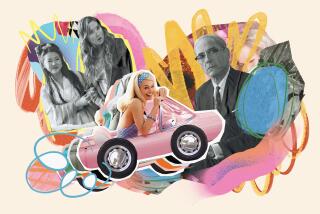Character changes ahead
- Share via
If Haley Joel Osment’s story were filmed, the movie would fall into the realm of fantasy. The 15-year-old Glendale resident was “discovered” at age 4, while shopping with his mother at IKEA. A Pizza Hut commercial led to a part in “Forrest Gump,” in which he played the title character’s son. After a series of sitcom roles, he received a best supporting actor Oscar nomination for his portrayal of a boy who could see dead people in “The Sixth Sense.” And his depiction of a robotic boy in “A.I. Artificial Intelligence” drew further raves for the youngster, whose “less is more” approach, critics said, gives him a maturity beyond his years.
On Sept. 19, Osment will appear with Michael Caine and Robert Duvall in Tim McCanlies’ “Secondhand Lions,” a comedic tale about an emotionally adrift boy deposited with two crusty great-uncles while his flighty mom goes husband-hunting. During one Texas summer, the men give him something to believe in and he, in return, gives them hope.
The director has said that you were his first choice for the role. Did you have to audition?
No. But I met with Tim about two years before the movie was made -- and about eight years after he wrote it. His script was on the list of “The 10 Best Screenplays That Were Never Made Into Movies,” published somewhere. This was a chance to play a character in transition, which fit me quite well. The year before the shoot began, I grew 4 inches and two shoe sizes, so you can’t play the same roles you’ve been playing between the ages of 10 and 13. Ron Howard and Jodie Foster are my role models. Beginning as child actors, they grew up to direct or deliver consistently great performances -- very hard to pull off.
Did the character of Walter present particular challenges? So much of the role is internal, reaction shots rather than dialogue.
Walter is an observer. At the beginning, he’s a pathetic, withdrawn kid who’s learned to stand back and watch. That worked into my natural approach because I try not to overplay. My dad -- an actor and my acting coach -- says that you have to be able to see yourself with a third eye, to know what you’ve done without playbacks or dailies. Robert [Duvall] is a master of subtlety, knowing how the smallest gestures translate onscreen. He plans everything out but, on the set, seems to be doing nothing. And Michael [Caine] is such a generous actor. He listens and uses what he’s doing to bring up the level of a scene. The two of them hadn’t seen each other since “The Eagle Has Landed” in the 1970s. Still, their relationship was an easy one and very important to the film.
Did watching the dailies help you make course corrections?
I don’t go to dailies. That’s another bit of advice from my dad. Finish the scene and don’t change it, he says. .
The conventional wisdom says that acting with children and animals is a no-win proposition. This film was packed with both.
I took a chance. Half the characters are kids, and the animals worked so well, in terms of humor and character, they were inserted at every opportunity. Linus, the bulldog, was the frontman for the dogs, a real showman who’d take the cap off a water bottle and perform tricks for the crew. The pig was easily distracted. Ungrateful it had been rescued from the bacon factory, it had its own agenda. Though we were hoping to keep it quiet, it was my stunt double, Marie Reeves, who had the courage to crawl into the cage with the lion. I wanted to do it, but the producers said “no way.” If Walter ended up missing an arm, it would have altered the script significantly.
-- Elaine Dutka
More to Read
Only good movies
Get the Indie Focus newsletter, Mark Olsen's weekly guide to the world of cinema.
You may occasionally receive promotional content from the Los Angeles Times.










